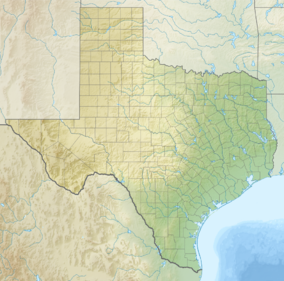Muleshoe National Wildlife Refuge: Difference between revisions
Sphilbrick (talk | contribs) NNL |
Added content Tags: Mobile edit Mobile web edit |
||
| Line 37: | Line 37: | ||
The refuge is a stop for migratory waterfowl flying between [[Canada]] and [[Mexico]]. The refuge includes several intermittent salt lakes, some of which have been modified to extend their wet periods. Paul's Lake, on the east side of Highway 214, is spring fed, and hosts wildlife during times when the other lakes are dry. If sufficient water is present during the winter, the refuge hosts tens of thousands of [[sandhill crane]]s. The largest number of cranes ever recorded was 250,000, during February, 1981. |
The refuge is a stop for migratory waterfowl flying between [[Canada]] and [[Mexico]]. The refuge includes several intermittent salt lakes, some of which have been modified to extend their wet periods. Paul's Lake, on the east side of Highway 214, is spring fed, and hosts wildlife during times when the other lakes are dry. If sufficient water is present during the winter, the refuge hosts tens of thousands of [[sandhill crane]]s. The largest number of cranes ever recorded was 250,000, during February, 1981. |
||
Other wildlife includes [[New World warbler|wood warbler]]s, [[meadowlark]]s, [[Bird of prey|raptor]]s, [[burrowing owl]]s, blacktailed [[prairie dog]]s, [[jackrabbit]]s, [[cottontail rabbit]]s, [[coyote]]s, and [[badger]]s. |
Other wildlife includes [[New World warbler|wood warbler]]s, [[meadowlark]]s, [[Bird of prey|raptor]]s, [[burrowing owl]]s, blacktailed [[prairie dog]]s, [[jackrabbit]]s, [[cottontail rabbit]]s, [[coyote]]s, [[black footed ferret]]s, [[spotted chorus frog]]s, and [[badger]]s. |
||
The [[prairie]] ecosystem includes plant life such as [[wildflower]]s, [[grass]]es, [[yucca]], [[cacti]], and [[mesquite]]. [[Rangeland management]] techniques include [[controlled burning]] and grazing. |
The [[prairie]] ecosystem includes plant life such as [[wildflower]]s, [[grass]]es, [[yucca]], [[cacti]], and [[mesquite]]. [[Rangeland management]] techniques include [[controlled burning]] and grazing. |
||
Revision as of 01:03, 11 July 2019
| Muleshoe National Wildlife Refuge | |
|---|---|
 Sandhill cranes at Muleshoe NWR photo by Wyman Meinzer | |
| Location | Bailey County, Texas |
| Nearest city | Muleshoe, Texas |
| Coordinates | 33°57′14″N 102°45′44″W / 33.95389°N 102.76222°W |
| Area | 6,440 acres (26.1 km2) |
| Established | 1935 |
| Governing body | U.S. Fish and Wildlife Service |
| www | |
Muleshoe National Wildlife Refuge is a 6,440-acre (26.1 km2) wildlife refuge located about twenty miles (32 km) south of Muleshoe, Texas on Texas State Highway 214. It is the oldest National Wildlife Refuge in the U.S. state of Texas, having been established as the Muleshoe Migratory Waterfowl Refuge by executive order of President Franklin D. Roosevelt in 1935.[1] Roosevelt issued a proclamation in 1940 changing the name to the Muleshoe National Wildlife Refuge.[2] In 1980, Muleshoe National Wildlife Refuge was designated as a National Natural Landmark by the National Park Service.[3]
The refuge is a stop for migratory waterfowl flying between Canada and Mexico. The refuge includes several intermittent salt lakes, some of which have been modified to extend their wet periods. Paul's Lake, on the east side of Highway 214, is spring fed, and hosts wildlife during times when the other lakes are dry. If sufficient water is present during the winter, the refuge hosts tens of thousands of sandhill cranes. The largest number of cranes ever recorded was 250,000, during February, 1981.
Other wildlife includes wood warblers, meadowlarks, raptors, burrowing owls, blacktailed prairie dogs, jackrabbits, cottontail rabbits, coyotes, black footed ferrets, spotted chorus frogs, and badgers.
The prairie ecosystem includes plant life such as wildflowers, grasses, yucca, cacti, and mesquite. Rangeland management techniques include controlled burning and grazing.
Northeast of White Lake is a small area of white gypsum dunes, similar to those found at White Sands National Monument in New Mexico, though these are much less expansive.
-
Entrance to Muleshoe National Wildlife Refuge
-
Sandhill cranes in flight, Muleshoe National Wildlife Refuge
-
Upper Goose Lake, Muleshoe National Wildlife Refuge
-
Official map of refuge
See also
- Grulla National Wildlife Refuge
- Buffalo Lake National Wildlife Refuge
- Blackwater Draw
- Llano Estacado
Reference
- ^ Lively, Jeanne F. "Muleshoe National Wildlife Refuge". Handbook of Texas Online. Texas State Historical Association. Retrieved 28 March 2018.
- ^ "Proclamation 2416". Wikisource. Retrieved 28 March 2018.
- ^ "National Natural Landmarks - National Natural Landmarks (U.S. National Park Service)". www.nps.gov. Retrieved 2019-03-30.
Year designated: 1980
External links
- Muleshoe National Wildlife Refuge Official Site
- Handbook of Texas Online: Muleshoe National Wildlife Refuge
- Photos of the Llano Estacado






